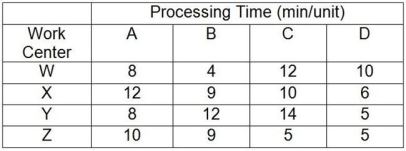Multiple Choice
Table 5.2
A company makes four products that have the following characteristics: Product A sells for $75 but needs $20 of materials and $20 of labor to produce; Product B sells for $90 but needs $45 of materials and $20 of labor to produce; Product C sells for $110 but needs $50 of materials and $30 of labor to produce; Product D sells for $135 but needs $75 of materials and $40 of labor to produce. The processing requirements for each product on each of the four machines are shown in the table.

Work centers W, X, Y, and Z are available for 40 hours per week and have no setup time when switching between products. Market demand is 50 As, 60 Bs, 70 Cs, and 80 Ds per week. In the questions that follow, the traditional method refers to maximizing the contribution margin per unit for each product, and the bottleneck method refers to maximizing the contribution margin per minute at the bottleneck for each product.
-Use the information in Table 5.2. Using the traditional method, which product should be scheduled first?
A) Product A
B) Product B
C) Product C
D) Product D
Correct Answer:

Verified
Correct Answer:
Verified
Q100: Table 5.1<br>A company makes four products that
Q101: Figure 5.4<br> <img src="https://d2lvgg3v3hfg70.cloudfront.net/TB1252/.jpg" alt="Figure 5.4
Q102: Figure 5.3<br> <img src="https://d2lvgg3v3hfg70.cloudfront.net/TB1252/.jpg" alt="Figure 5.3
Q103: Balance the line in order to achieve
Q104: Which statement about transfer batch sizes is
Q106: Table 5.2<br>A company makes four products that
Q107: _ is the amount by which efficiency
Q108: Table 5.1<br>A company makes four products that
Q109: There are three consecutive steps in a
Q110: Figure 5.4<br> <img src="https://d2lvgg3v3hfg70.cloudfront.net/TB1252/.jpg" alt="Figure 5.4